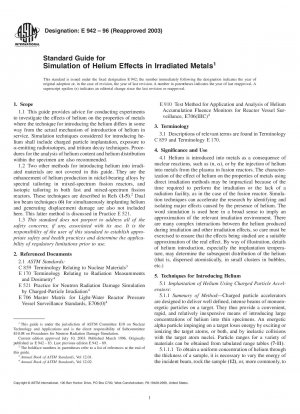ASTM E942-96(2003)
Standard Guide for Simulation of Helium Effects in Irradiated Metals
- Standard No.
- ASTM E942-96(2003)
- Release Date
- 1996
- Published By
- American Society for Testing and Materials (ASTM)
- Status
- Replace By
- ASTM E942-96(2011)
- Latest
- ASTM E942-23
- Scope
Helium is introduced into metals as a consequence of nuclear reactions, such as (n, α), or by the injection of helium into metals from the plasma in fusion reactors. The characterization of the effect of helium on the properties of metals using direct irradiation methods may be impractical because of the time required to perform the irradiation or the lack of a radiation facility, as in the case of the fusion reactor. Simulation techniques can accelerate the research by identifying and isolating major effects caused by the presence of helium. The word simulation is used here in a broad sense to imply an approximation of the relevant irradiation environment. There are many complex interactions between the helium produced during irradiation and other irradiation effects, so care must be exercised to ensure that the effects being studied are a suitable approximation of the real effect. By way of illustration, details of helium introduction, especially the implantation temperature, may determine the subsequent distribution of the helium (that is, dispersed atomistically, in small clusters in bubbles, etc.)
1.1 This guide provides advice for conducting experiments to investigate the effects of helium on the properties of metals where the technique for introducing the helium differs in some way from the actual mechanism of introduction of helium in service. Simulation techniques considered for introducing helium shall include charged particle implantation, exposure to -emitting radioisotopes, and tritium decay techniques. Procedures for the analysis of helium content and helium distribution within the specimen are also recommended.
1.2 Two other methods for introducing helium into irradiated materials are not covered in this guide. They are the enhancement of helium production in nickel-bearing alloys by spectral tailoring in mixed-spectrum fission reactors, and isotopic tailoring in both fast and mixed-spectrum fission reactors. These techniques are described in Refs (1-5). Dual ion beam techniques (6) for simultaneously implanting helium and generating displacement damage are also not included here. This latter method is discussed in Practice E 521.
1.3 This standard does not purport to address all of the safety concerns, if any, associated with its use. It is the responsibility of the user of this standard to establish appropriate safety and health practices and determine the applicability of regulatory limitations prior to use.
ASTM E942-96(2003) Referenced Document
- ASTM C859 Standard Terminology Relating to Nuclear Materials
- ASTM E170 Standard Terminology Relating to Radiation Measurements and Dosimetry*, 1999-04-19 Update
- ASTM E521 Standard Practice for Neutron Radiation Damage Simulation by Charged-Particle Irradiation
- ASTM E706 Standard Master Matrix for Light-Water Reactor Pressure Vessel Surveillance Standards, E706(0)
- ASTM E910 Standard Test Method for Application and Analysis of Helium Accumulation Fluence Monitors for Reactor Vessel Surveillance, E706 (IIIC)
ASTM E942-96(2003) history
- 2023 ASTM E942-23 Standard Guide for Investigating the Effects of Helium in Irradiated Metals
- 2016 ASTM E942-16 Standard Guide for Investigating the Effects of Helium in Irradiated Metals
- 1996 ASTM E942-96(2011) Standard Guide for Simulation of Helium Effects in Irradiated Metals
- 1996 ASTM E942-96(2003) Standard Guide for Simulation of Helium Effects in Irradiated Metals
- 1996 ASTM E942-96 Standard Guide for Simulation of Helium Effects in Irradiated Metals
